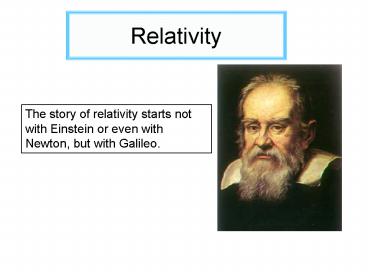Relativity - PowerPoint PPT Presentation
Title:
Relativity
Description:
Relativity The story of relativity starts not with Einstein or even with Newton, but with Galileo. Reference frames Both right! Galilean transformation No absolute ... – PowerPoint PPT presentation
Number of Views:90
Avg rating:3.0/5.0
Title: Relativity
1
Relativity
The story of relativity starts not with Einstein
or even with Newton, but with Galileo.
2
Reference frames
Galileo thought about how the same event would
look to different observers.
One observer sees the ball go straight up and
down. The other observer sees the ball go in a
parabola. Whos right??
3
Both right!
Theyre both right of course, and Galileo wrote
down the rule for going from one reference frame
to another.
S
S
S moves with velocity V along the x-axis of S.
V
x
x
4
Galilean transformation
Observations in different frames are related by
the Galilen transformations x x-Vt
Vrelative velocity of the frames yy tt Knowin
g what happens on the cart allows you to know
what the observer on the ground saw, and
vice-versa.
5
No absolute motion
Newton articulated the idea that there is no such
thing as absolute motion or reference frame.
All inertial frames are equivalent, and the
laws of physics are the same in all frames.
Inertialmoving with constant velocity, ie not
accelerated.
6
No absolute motion
If you are in a railroad car with no windows or
doors, moving at constant velocity, there is NO
EXPERIMENT that you can do to tell that you are
moving. Youre NOT moving, as far as you can
tell.
A ball on a string hangs straight, as long as V
is constant
V
7
Accelerated motion
In contrast you CAN tell if you are being
accelerated.
a
If the car is accelerating, the ball hangs at an
angle. But special relativity deals only with
inertial frames.
8
Maxwells equations
The 1800s saw the discovery of the wave nature
of light (Young, 1802) and the discovery of the
laws of electromagnetism, culminating in
Maxwells Equations in 1873.
9
Maxwells Equations
Maxwells amazing discovery was that c2
µ0?0 Constants that arose in electrostatics and
magnetostatics gave the speed of light!
10
Light propagation
If light is a wave, it needs a medium, just like
sound waves need a medium. The speed of
propagation is defined with respect to the
medium. (This was the thinking in 1900).
11
Michaelson-Morley experiment
Michaelson spent years attempting to measure the
motion of the earth through the aether.
12
Michaelson-Morley experiment
A very sensitive interferometer rotated on a bed
of mercury. The interference fringes should
shift if the earth is moving through the aether.
13
Michaelson-Morley experiment
In his final experiment, done in 1887,
Michaelson, along with Morley, had an apparatus
with a sensitivity of .005 fringes. The expected
effect was a shift of the interference pattern of
0.4 fringes. They measured NO shift of the
interference fringes. The result of the
hypothesis of a stationary ether is thus shown to
be incorrect.--Michaelson Experiment is the
sole judge of scientific truth. Feynman
14
Enter Einstein
The laws of physics are the same in all reference
framesand therefore The speed of light is the
same in all reference frames, independent of the
motion of the source or observer.
15
Velocity addition classically
If you throw a baseball out of a moving train
with velocity vo, an observer on the ground sees
it moving with velocity V vo
The ball is moving toward me at Vvo
V
vo velocity of ball with respect to the train
16
Velocity addition for light?
If you shine a flashlight out the front of a
moving train, what does an observer on the ground
measure for the velocity of the wavefront of
light?
The light is moving away from me at c
The light is moving toward me at c
V
Beam of light































